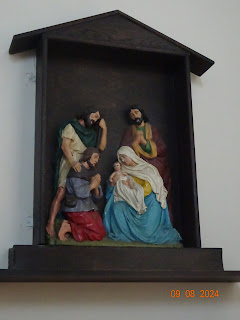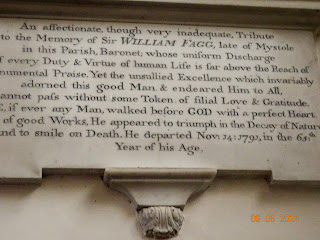Chartham is currently making a bit of a name for itself by producing wines. However, until recently, it was better known for having the largest paper mill in Europe. The Mill probably started life by grinding corn, and later it became a fulling mill for woven cloth. By 1730, it had become a paper mill, and remained so until its' closure. It changed hands several times, but in 1939 became noted for its tracing paper. It produced all the tracing paper the War Department needed, for it is a necessary tool for designers of everything, from tanks to radar. Now it is derelict.
The other thing Chartham became noted for, was the Lunatic Asylum, which later became St. Augustine's Mental Hospital. That too has closed.
.
As it turned out, what is left of the former St. Augustine's Asylum and Hospital has been converted into houses and apartments, and the alterations are so great, it is difficult to envisage how it must have looked in its' former life. So I am going to take the unusual step (for me) of using old photographs to illustrate the story of what was an important part of Chartham's history.
I must stress, that I have used the terminology of the day in the descriptions. We all know that the descriptions of the people involved were unfair, and are far more decent these days, but places like this existed because anybody who was seen as 'different' to the norm, was considered to be a 'lunatic', and that's how they were named. Thankfully, with the improvement of knowledge of mental health issues, and genetic or hereditary issues, people are looked upon in the same way as patients with physical illnesses and injuries these days.
This picture shows just how large the mental hospital was.
From 1833 to 1872 the County of Kent managed to provide accommodation for inmates at its lunatic asylum in Barming Heath near Maidstone, however it was becoming obvious by this point that despite various additions, a second asylum site would be required. It was determined by the visiting committee that the new asylum should be more convenient for the population of East Kent who were remote from the present site at Barming Heath and a suitable site at Chartham, near Canterbury, was selected. And so Chartham Lunatic Asylum came into being.
In the 1920s, it became known as Chartham Mental Hospital. Overcrowding, was eased by the construction of the new colony for Kent’s Mental Defectives at Leybourne Grange near Ryarsh, enabling people with what would now be termed learning disabilities to be moved to their own dedicated institution.
With the intervention of World War II the new admissions unit was requisitioned for the military and never returned to its intended use, becoming a neurological unit. The main hospital was then approaching its most overcrowded having received additional patients from other mental hospitals required for war use. Under the NHS the hospital was renamed St. Augustine’s Hospital and developed closer links with the nearby St. Martin’s Hospital, Canterbury, resulting in a joint management committee and re-arrangement of bed utilisation across the two sites. St. Martin’s became the more acute site with longer stay chronic patients based at the more remote St. Augustine’s.
As part of the process of discharging long stay psychiatric patients into community settings, St. Augustine’s was earmarked as one of the earlier closures. At St. Augustine’s, wards were gradually closed and services contracted towards the core of the site allowing outlying structures to be emptied and sealed. The hospital eventually closed during late 1993.

St. Mary's church.

I parked opposite the church and wandered in. Immediately, I was greeted by a little curly ginger thing that bore more resemblance to a teddy bear than a dog, and which was obviously very pleased to see me. Me: getting down to cuddle him "Hello poppet, who are you then?"
Disembodied voice: "Hello, I'm the new vicar of St. Mary's"
Me: "I kinda guessed that from your pretty blue dog collar"
Disembodied voice: silence, followed shortly after by a huge eruption of laughter, when he realised I was still talking to the dog 
The new Vicar emerged from behind a pillar, and introduced me to Benji, who promptly demanded to go for a walk.
The church is light and airy, and has a pleasant atmosphere. It also has a very odd modern wooden screen at the West end of the nave. Even the new vicar is a bit perplexed as to why, and of what use it is.
There are a few memorials, the most famous of which is the brass to Sir Robert de Septvans (d. 1306), one of the oldest and largest memorial brasses in the country, showing the cross-legged knight with flowing locks. The crossed legs usually denote that the knight was a crusader.
There is a board explaining what is known of Sir Robert.

The brass itself has been rescued from the floor to protect it, and there is also a full-size reproduction of it so that you can see the details clearly.
There is also a colour representation of him, painted on a glass panel. A matching glass panel shows characters from Chaucer's 'Canterbury Tales'

So what do we know of Robert de Septvans? There is a lot of confusion over which Robert is which. By tradition, the first-born son carried the name. This one, however, was born c1250.
He probably took part in the 9th. Crusade, under Prince Edward, who later became Edward I, and who later endowed Chartham church.
The name Septvans probably derives from 'Septem Vannis' (seven winnowing fans used to separate the wheat from chaff in the threshing process), a distinctive design which appears to have been the emblem of his family and which also appears on the commemorative brass. The de Septvans' family motto 'Dissipabo inimicos Regis mei ut paleam'. 'The enemies of my King will I disperse like chaff' suggests a connection between the family emblem and the sentiment of their motto.
In 1275 Sir Robert was made Constable of Rochester Castle. Rochester Castle was strategically important as it dominated the Medway estuary and was regarded as an essential part of the defence of South East England. However, this would also have been at a period of managing decline at the castle as, due to the effects of a siege in 1264, much of the castle was burnt out ruins. It had also suffered from many years of pilfering of materials from what remained. As a Knight for the Shire of Kent, Sir Robert's association with the monarch continued. In 1300 he fought with King Edward I at the battle Caerlaverock, on the southern coast of Scotland, and continued northwards with the King's army to fight against the Scots led by William Wallace. At the siege of Caerlaverock Castle he was created a knight banneret by the King for gallantry. In medieval
times this was an honour bestowed by the monarch and meant that a knight could bring a company of his own followers into the field of battle under his own banner. Under English custom the rank of knight banneret could only be conferred by the King on the field of battle. The military rank of knight banneret was higher than that of knight bachelor (who fought under another's banner), but lower than that of an earl or a duke.
In 1304, with his increasing infirmity, he was relieved of this role and eventually died in 1306. He was buried in St Mary's at Chartham, probably close to the altar as befitted his rank and achievements. And so St Mary's Church at Chartham became the final resting place for Sir Robert de Septvans, a 13th Century Medieval Knight.
This church has plenty of explanatory boards like this.
Brass memorial to Lt. Col. Charles Peter Marten, who was killed in action on the Somme, aged 36. He was the son of Capt. S.W. Marten of the East Kent Militia, who lived at Shalmsford Bridge Manor, just down the road from Chartham. He was buried in Serre Cemetery, France.
Tomb of Sir William Young, Baronet, and his first wife, Sarah. Another verbose tribute. Young was born in Antigua, and went on to become Governor of Dominica.
I kept coming across references to the Fagg family of Mystole. I had never heard of Mystole before this. It seems to be a small collection of buildings just outside Chartham - too small to be even called a hamlet. Further investigation is needed. I am assuming there was once a larger house there. All I have found so far, is that he married Elizabeth Le Grand



















No comments:
Post a Comment